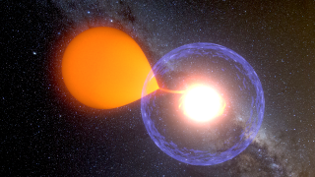A new class of cosmic X-ray sources discovered
2024-12-18

An international team of astronomers, led by researchers from the Astronomical Observatory of the University of Warsaw, have identified a new class of cosmic X-ray sources. The findings have been published in „Astrophysical Journal Letters”.
Most people encounter X-rays during medical visits, where they are used to create images of bones or diagnose lung conditions. These X-rays are generated using artificial sources.
However, not everyone knows that celestial objects can also emit X-ray radiation.
“Some cosmic phenomena produce X-rays naturally,” explains Dr. Przemek Mróz, the lead author of the study. “For example, X-rays may be produced by a hot gas falling onto compact objects like white dwarfs, neutron stars, or black holes. X-rays can also be generated by decelerating charged particles, such as electrons.”
The researchers identified a group of 29 unusual objects in the Magellanic Clouds, the two nearby satellite galaxies of the Milky Way. These objects displayed unexpected behavior: they exhibited long-duration (typically a few months) outbursts, during which they brightened by 10 to 20 times their usual brightness. While some of these objects exhibited recurring outbursts every few years, others flared up only once during the observation period.
The team discovered these objects by analyzing over 20 years of data collected by the Optical Gravitational Lensing Experiment (OGLE) survey, led by astronomers from the University of Warsaw.
One detected object, named OGLE-mNOVA-11, began an outburst in November 2023, providing a unique opportunity for a detailed study.
"We observed this star with the Southern African Large Telescope (SALT), one of the largest telescopes in the world,” says Dr. Mróz. “Its optical spectrum revealed signatures of ionized atoms of helium, carbon, and nitrogen, indicating extremely high temperatures.”
The star was also observed by the Neil Gehrels Swift Observatory, which detected X-rays corresponding to a temperature of 600,000 degrees Celsius. Given its distance of over 160,000 light years, OGLE-mNOVA-11 emitted more than 100 times the luminosity of the Sun.
The object’s unusual properties closely resembled another system, called ASASSN-16oh, discovered in 2016 by the All Sky Automated Survey for SuperNovae.
“We believe OGLE-mNOVA-11, ASASSN-16oh, and the other 27 objects form a new class of transient X-ray sources,” says Dr. Mróz. “We’ve named them millinovae, as their peak brightness is roughly a thousand times lower than that of classical novae.”
Millinovae are thought to be binary star systems consisting of two objects orbiting each other with a period of a few days. A white dwarf—a dense remnant of a once-massive star—closely orbits a subgiant star that has exhausted the hydrogen in its core and expanded. The proximity between the two stars allows material to flow from the subgiant to the white dwarf.The source of the X-rays remains a mystery, but scientists have proposed two possible explanations. According to one scenario, the X-rays might be produced as the subgiant’s material falls onto the white dwarf’s surface, releasing energy.
Alternatively, the X-rays could result from a thermonuclear runaway on the white dwarf surface.
As material accumulates on the white dwarf, hydrogen ignites, causing a thermonuclear explosion—but not a violent enough one to eject material.
If the latter hypothesis is correct, then millinovae may play a crucial role in astrophysics. As a white dwarf grows in mass, it can eventually reach a critical threshold (about 1.4 solar masses), at which point it may explode as a Type Ia supernova.Astronomers use Type Ia supernovae as standard candles for measuring cosmic distances. In particular, observations of Type Ia supernovae led to the discovery of accelerating expansion of the Universe, a finding that won the 2011 Nobel Prize in Physics. However, the exact progenitors of Type Ia supernovae remain unknown.
The article is a collaboration between scientists from the Astronomical Observatory of the University of Warsaw and researchers from, among others, the University of Southampton, the University of Leicester (UK), the University of Cape Town and the University of the Free State (South Africa).
Faculty of Physics of the University of Warsaw
Physics and astronomy at the University of Warsaw appeared in 1816 as part of the then Faculty of Philosophy. In 1825, the Astronomical Observatory was established. Currently, the Faculty of Physics at the University of Warsaw consists of the following institutes: Experimental Physics, Theoretical Physics, Geophysics, the Department of Mathematical Methods in Physics, and the Astronomical Observatory. The research covers almost all areas of modern physics on scales from quantum to cosmological. The Faculty's research and teaching staff consists of over 250 academic teachers. About 1,100 students and over 170 doctoral students study at the Faculty of Physics UW. The University of Warsaw is among the 300 best universities in the world, educating in the field of physics according to Shanghai’s Global Ranking of Academic Subjects.
SCIENTIFIC PUBLICATION:
P. Mróz, K. Król, H. Szegedi, P. Charles, K. L. Page, A. Udalski, D. Buckley, G. Dewangan, P. Meintjes, M. K. Szymański, I. Soszyński, P. Pietrukowicz, S. Kozłowski, R. Poleski, J. Skowron, K. Ulaczyk, M. Gromadzki, K. Rybicki, P. Iwanek, M. Wrona, M. J. Mróz, Millinovae: a new class of transient supesoft X-ray sources without a classical nova eruption, 2024, ApJL, 977, 37. https://doi.org/10.3847/2041-8213/ad969b
CONTACT:
dr Przemysław Mróz
Astronomical Observatory of the University of Warsaw
email: pmroz@astrouw.edu.pl
RELATED WEBSITES WWW:
https://www.fuw.edu.pl/faculty-of-physics-home.html
Website of the Faculty of Physics University of Warsaw
https://www.astrouw.edu.pl/
Website of the Astronomical Observatory of the University of Warsaw
GRAPHIC MATERIALS:
FUW241218b_fot01.png
https://www.fuw.edu.pl/tl_files/press/images/2024/FUW241218b_fot01.png
Artist’s impression of a classical nova eruption. Credit: Krzysztof Ulaczyk / Astronomical Observatory, University of Warsaw.





